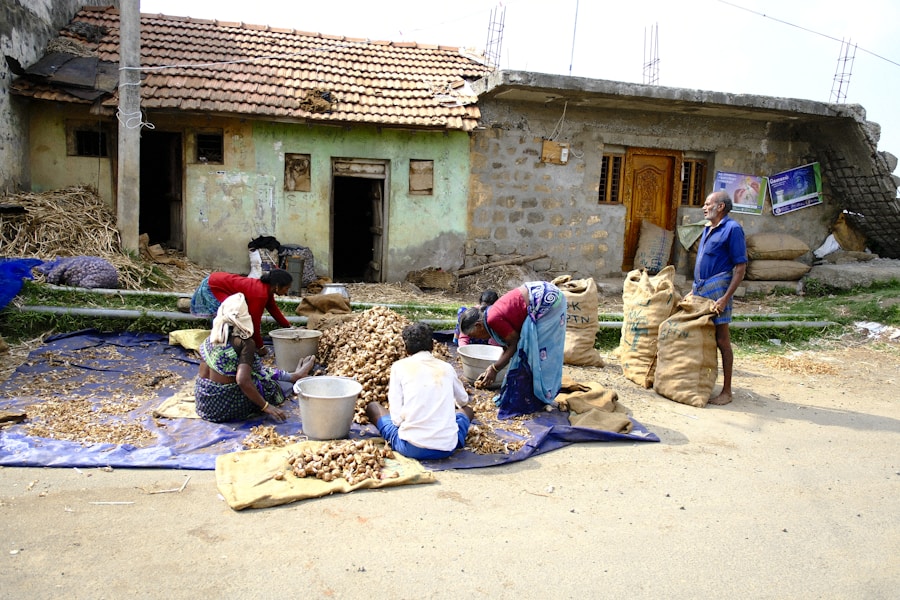Soil health is a critical component of agricultural and environmental sustainability. It refers to the overall condition of the soil, including its physical, chemical, and biological properties. Healthy soil is essential for supporting plant growth, maintaining water quality, and promoting biodiversity. The key indicators of soil health include soil structure, nutrient availability, microbial activity, and organic matter content. Soil health is influenced by a variety of factors, including land management practices, climate, and the type of soil. Understanding the basics of soil health is crucial for farmers, land managers, and policymakers to make informed decisions about sustainable land use and conservation practices.
Soil structure is an important aspect of soil health, as it affects water infiltration, root penetration, and air exchange within the soil. A well-structured soil allows for better water retention and drainage, which is essential for supporting plant growth. Nutrient availability is another key factor in soil health, as it determines the ability of plants to access essential nutrients for growth and development. Microbial activity in the soil is also crucial for nutrient cycling and organic matter decomposition. Finally, organic matter content is a key indicator of soil health, as it provides essential nutrients for plant growth and supports microbial activity. Overall, understanding the basics of soil health is essential for promoting sustainable land management practices and ensuring the long-term productivity of agricultural lands.
The Impact of Soil Health on Plant Growth and Crop Yields
Soil health has a direct impact on plant growth and crop yields. Healthy soil provides the necessary nutrients, water, and support for plants to thrive. A well-structured soil with good water retention and drainage allows for optimal root development and access to water and nutrients. Nutrient availability in the soil is crucial for supporting plant growth, as it determines the ability of plants to access essential nutrients such as nitrogen, phosphorus, and potassium. Microbial activity in the soil is also important for promoting nutrient cycling and making nutrients available to plants. Additionally, organic matter content in the soil provides essential nutrients for plant growth and supports microbial activity.
The impact of soil health on plant growth and crop yields is significant. Healthy soil can lead to increased crop yields, improved crop quality, and reduced input costs. By promoting healthy soil, farmers can reduce the need for synthetic fertilizers and pesticides, which can have negative impacts on the environment and human health. Additionally, healthy soil can help plants withstand environmental stresses such as drought, flooding, and disease. Overall, understanding the impact of soil health on plant growth and crop yields is essential for promoting sustainable agriculture and ensuring food security for future generations.
Factors Affecting Soil Health
There are several factors that can affect soil health, including land management practices, climate, and the type of soil. Land management practices such as tillage, crop rotation, cover cropping, and organic amendments can have a significant impact on soil health. For example, excessive tillage can lead to soil compaction and erosion, while cover cropping can improve soil structure and organic matter content. Climate also plays a role in soil health, as temperature and precipitation can affect microbial activity, nutrient cycling, and organic matter decomposition. The type of soil, including its texture, structure, and composition, can also influence its overall health.
In addition to these factors, human activities such as urbanization, industrialization, and deforestation can have negative impacts on soil health. For example, urbanization can lead to soil compaction and contamination from pollutants such as heavy metals and chemicals. Industrialization can lead to soil contamination from industrial waste and emissions. Deforestation can lead to erosion and loss of organic matter in the soil. Overall, understanding the factors that affect soil health is crucial for developing sustainable land management practices and mitigating the negative impacts of human activities on soil health.
Techniques for Enhancing Soil Health
There are several techniques that can be used to enhance soil health, including conservation tillage, cover cropping, crop rotation, organic amendments, and agroforestry. Conservation tillage involves reducing or eliminating tillage to minimize soil disturbance and erosion. Cover cropping involves planting a temporary crop to cover the soil surface and improve soil structure and organic matter content. Crop rotation involves alternating different crops on the same land to improve nutrient cycling and reduce pest pressure. Organic amendments such as compost and manure can be added to the soil to improve nutrient availability and microbial activity. Agroforestry involves integrating trees into agricultural landscapes to improve soil structure, nutrient cycling, and biodiversity.
In addition to these techniques, precision agriculture technologies such as GPS-guided tractors and variable rate application can be used to optimize inputs such as fertilizers and pesticides, reducing their impact on soil health. Soil testing and monitoring can also be used to assess soil health and make informed decisions about land management practices. Overall, understanding the techniques for enhancing soil health is crucial for promoting sustainable agriculture and ensuring the long-term productivity of agricultural lands.
The Role of Soil Health in Environmental Sustainability
Soil health plays a critical role in environmental sustainability. Healthy soil supports biodiversity by providing habitat for a wide range of organisms such as earthworms, insects, fungi, and bacteria. These organisms play important roles in nutrient cycling, organic matter decomposition, and pest control. Healthy soil also helps maintain water quality by filtering out pollutants and reducing runoff into water bodies. Additionally, healthy soil helps mitigate climate change by sequestering carbon from the atmosphere through the accumulation of organic matter.
The role of soil health in environmental sustainability is particularly important in the context of climate change. Healthy soils can help mitigate climate change by sequestering carbon from the atmosphere through the accumulation of organic matter. This process helps reduce greenhouse gas emissions and mitigate the impacts of climate change on agriculture. Additionally, healthy soils can help plants withstand environmental stresses such as drought, flooding, and disease, which are expected to become more frequent and severe with climate change. Overall, understanding the role of soil health in environmental sustainability is crucial for promoting sustainable land management practices and mitigating the impacts of climate change on agriculture.
The Importance of Soil Health in Carbon Sequestration
Soil health plays a crucial role in carbon sequestration, which refers to the process of capturing carbon from the atmosphere and storing it in the soil. Healthy soils can sequester significant amounts of carbon through the accumulation of organic matter. This process helps reduce greenhouse gas emissions and mitigate the impacts of climate change on agriculture. In addition to sequestering carbon from the atmosphere, healthy soils also help reduce greenhouse gas emissions by minimizing the need for synthetic fertilizers and pesticides.
The importance of soil health in carbon sequestration is particularly important in the context of climate change. As global temperatures continue to rise, it is crucial to find ways to mitigate greenhouse gas emissions and reduce the impacts of climate change on agriculture. Healthy soils play a key role in this effort by sequestering carbon from the atmosphere through the accumulation of organic matter. This process helps reduce greenhouse gas emissions and mitigate the impacts of climate change on agriculture. Overall, understanding the importance of soil health in carbon sequestration is crucial for promoting sustainable land management practices and mitigating the impacts of climate change on agriculture.
Resources for Monitoring and Improving Soil Health
There are several resources available for monitoring and improving soil health, including soil testing laboratories, extension services, government agencies, non-profit organizations, and research institutions. Soil testing laboratories can provide farmers with information about their soil’s nutrient levels, pH, organic matter content, and microbial activity. Extension services can provide farmers with information about sustainable land management practices such as conservation tillage, cover cropping, crop rotation, organic amendments, and agroforestry.
Government agencies such as the Natural Resources Conservation Service (NRCS) provide technical assistance to farmers for implementing conservation practices that improve soil health. Non-profit organizations such as the Soil Health Institute work to advance soil health research and education through partnerships with farmers, industry stakeholders, government agencies, and research institutions. Research institutions conduct research on innovative techniques for enhancing soil health such as precision agriculture technologies and biochar application.
Overall, there are many resources available for monitoring and improving soil health that can help farmers make informed decisions about sustainable land management practices.
In conclusion, understanding the basics of soil health is crucial for promoting sustainable land management practices and ensuring the long-term productivity of agricultural lands. Soil health has a direct impact on plant growth and crop yields through its influence on nutrient availability, water retention, microbial activity, and organic matter content. Factors affecting soil health include land management practices, climate, type of soil, urbanization, industrialization, deforestation among others. Techniques for enhancing soil health include conservation tillage cover cropping crop rotation organic amendments agroforestry among others.
Soil health plays a critical role in environmental sustainability by supporting biodiversity maintaining water quality mitigating climate change through carbon sequestration among others. The importance of soil health in carbon sequestration cannot be overstated as it helps reduce greenhouse gas emissions mitigate climate change impacts on agriculture among others.
There are several resources available for monitoring improving soil health including soil testing laboratories extension services government agencies non-profit organizations research institutions among others that can help farmers make informed decisions about sustainable land management practices.
These resources can provide valuable information on soil nutrient levels, pH, organic matter content, and potential contaminants. They can also offer guidance on soil conservation practices, cover cropping, crop rotation, and other strategies to improve soil health and productivity. By utilizing these resources, farmers can gain a better understanding of their soil’s needs and develop effective plans for sustainable agriculture.



